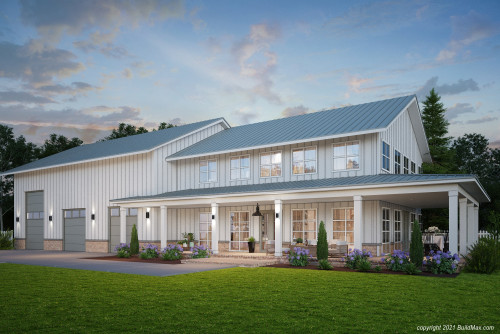Barndominium Builder and Style Services: Personalized Houses Constructed to Last
Barndominiums Vs. Traditional Homes: a Detailed Comparison of Way Of Life and Performance
The choice between barndominiums and standard homes incorporates different variables, including way of living preferences and useful needs. Barndominiums are defined by their open layouts and flexibility, commonly appealing to those who prioritize public living and flexibility.
Summary of Barndominiums
Barndominiums, a novel housing fad obtaining appeal throughout various regions, blend the rustic charm of barn-style design with the capability of modern-day space. These one-of-a-kind structures usually include a steel or timber framework, incorporating open flooring strategies and high ceilings with energy-efficient attributes. Typically located on extensive rural properties, barndominiums supply property owners the chance to delight in a tranquil way of life while providing ample room for various tasks.
The versatility of barndominiums extends beyond their aesthetic appeal; they can serve as both living quarters and functional rooms for pastimes, workshops, and even local business. Their flexible design allows for easy customization, fitting varied household demands and choices. Numerous owners appreciate the reduced maintenance requirements connected with metal home siding and roof covering, adding to long-term toughness.

Characteristics of Typical Houses
Emphasizing timeless layout and convenience, traditional homes are characterized by their distinctive architectural designs, which typically show historical influences and regional aesthetic appeals. Common functions consist of symmetrical facades, gabled roofings, and an emphasis on workmanship, leading to a cozy and inviting environment.
Traditional homes commonly integrate aspects such as crown molding, wainscoting, and hardwood floor covering, enhancing their classic allure. They typically feature several spaces with defined objectives, promoting family members communication while permitting privacy. visit website. The design frequently consists of official living and eating areas, which contribute to entertaining visitors and organizing household gatherings
Exterior materials such as brick, timber, or rock are often utilized, adding to durability and a feeling of permanence. Barndominium repair. Furthermore, numerous standard homes are made with front verandas or stoops, fostering a sense of neighborhood and connection with the area
Landscape design plays a significant role in conventional home design, with well-maintained gardens and pathways that improve visual charm - click here. In general, standard homes symbolize a feeling of fond memories and security, interesting those that value heritage and a much more organized living atmosphere
Expense Comparison
Normally, an expense comparison in between barndominiums and traditional homes discloses considerable differences in building and construction expenses and overall financial investment. Barndominiums, frequently constructed from metal or steel frames, generally incur lower material and labor prices than conventional homes constructed from timber and block. The streamlined layout of barndominiums can translate to lowered construction times, even more lowering labor expenses and expediting occupancy.
Usually, the cost per square foot for a barndominium varies from $100 to $150, while conventional homes can vary widely, generally falling between $150 and $300 per square foot, depending upon place, products, and design intricacy. This cost disparity makes barndominiums an eye-catching choice for budget-conscious buyers seeking larger space without giving up top quality.
Additionally, barndominiums may cause lasting cost savings through reduced maintenance costs, energy effectiveness, and insurance coverage prices. Their sturdy building and construction products often call for much less upkeep over time contrasted to standard homes. Nevertheless, it is important to consider that while preliminary prices may be lower for barndominiums, the last investment will also rely on specific customization and desired amenities, which can affect the total expenditure in both real estate types.
Way Of Life and Room Considerations
When considering way of life and area, barndominiums supply a distinct adaptability that interest a visite site selection of homeowners. These hybrid frameworks combine residential living with useful room, commonly including open layout that can be adapted to match specific demands. This adaptability is specifically helpful for families or individuals seeking a tailored living setting, enabling diverse uses such as home workplaces, workshops, or entertainment locations.

In addition, the visual appeal of barndominiums can cater to both rustic and modern tastes, making them a versatile choice for various design choices (Barndominium builder). Ultimately, the option in between a barndominium and a typical home commonly hinges on how well each choice straightens with the house owner's way of living goals and spatial requirements, highlighting the relevance of taking into consideration personal top priorities in the decision-making procedure
Environmental Influence and Sustainability
The ecological effect and sustainability of barndominiums present engaging advantages contrasted to typical homes. Mostly built from steel and various other long lasting materials, barndominiums are often built utilizing recycled resources, decreasing the need for new products and minimizing waste. Their design generally highlights open rooms, which can bring about reduced power intake for heating and cooling compared to traditional homes with even more fractional formats.
Moreover, barndominiums can include lasting features such as solar panels, rainwater harvesting systems, and progressed insulation techniques, improving their energy effectiveness. The versatility of their style allows property owners to incorporate these technologies a lot more flawlessly than in several traditional homes, which may require considerable retrofitting.
In addition, barndominiums often need fewer sources for construction as a result of their simpler, more effective designs. This not only reduces the carbon impact linked with building however likewise adds to an extra lasting lifestyle. In contrast, traditional homes may entail greater degrees of power expenditure and source utilize throughout their lifecycle, from building and construction to maintenance. In general, barndominiums represent a forward-thinking strategy to lasting living, straightening with modern ecological concerns.
Verdict
In recap, the option in between barndominiums and standard homes pivots on private lifestyle preferences and practical needs. Barndominiums, with their open layouts and lasting materials, provide to those seeking adaptability and common living. Conversely, conventional homes provide defined rooms that boost personal privacy and copyright historical looks. Each alternative presents special advantages, demanding careful consideration of one's values and requires when figuring out the most suitable living atmosphere.